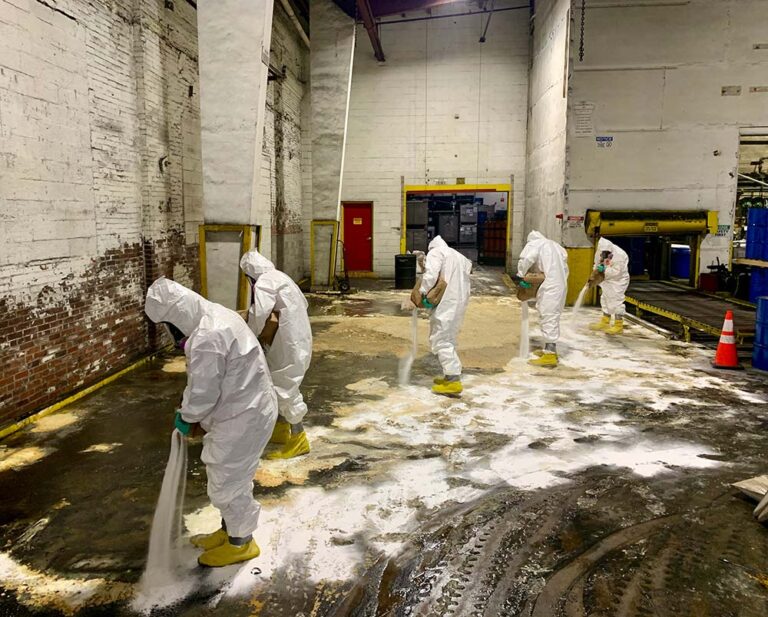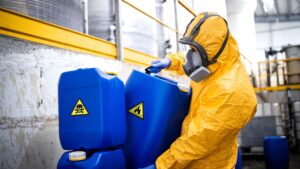HAZMAT is short for “hazardous material”–substances or chemicals that could present a threat to health, physical property, and environmental health. HAZMAT material can be dangerous goods in liquid, solid, or gaseous states or could exist in any combination of the three.
Examples of Hazardous Materials:
- Hydrofluoric acid, HF
- Hydrochloric acid, HCl
- Lead Paint
- Asbestos
- Coal Tar: contains VOCs, SVOCs, PAHs, and TPH (Benzene, Toluene, Ethyl Benzene, Xylene)
- Non-RCRA Regulated Waste
- RCRA: drives all hazardous waste regulation
- Toxic Heavy Metals
- Toxic chemicals
- Radioactive material
- Chemical waste
Emerging Contaminants
An emerging contaminant, according to the EPA, is a chemical or a toxic substance that poses a threat to human health or the environment. An emerging contaminant could also be due to the discovery of a new source of contamination or a new route for humans.
Per- and Polyfluoroalkyl Substances
A group of more than 4,000 chemicals made by man, collectively known as Per- and Polyfluoroalkyl Substances (PFAS). They have been identified as emerging contaminants that can have serious adverse effects on human health even at low levels in the parts-per-thousand range.
Sources of PFAS
PFAS have been around since the 1940s and are still being used worldwide. PFAS are used in thousands of industrial and consumer products due to their chemical stability, heat resistance, and ability to repel oil and water. These are some of the places where PFAS can be found:
- Non-Stick cooking ware
- Food packaging with grease-resistant or waterproof coatings (e.g. takeout containers, popcorn bags, and wrappers for fast food)
- Products made from coated paper
- Textiles that are waterproof, water-resistant, and stain-resistant (e.g. clothing, shoes, and upholstery)
- Cleaning products for industrial and domestic use
- Waxes for floor, car, and boat
- Use of Engineered Coatings in Semiconductor Production
- Metal plating and metal finishing
- Etching metals, plastics, and glass
- Paint, varnish, and surface coatings
- Electronics cables and insulation with wire insulation
- To extinguish flammable liquid flames, AFFF (Aqueous Film-Forming Foam) is used.
Although PFAS are found in the environment, they are not naturally occurring. These substances can easily be spread by water and air because they are mobile. They can cause soil, groundwater, and surface water contamination. They can remain in the environment for many years because they are not easily broken down by nature.
Toxicity and health effects
The human health and environmental impacts of PFAS are rapidly changing. Ingestion of some PFAS has been shown to bioaccumulate (accumulate in the body) in both animals and humans. Certain PFAS have been shown to cause health problems, including developmental effects in infants and fetuses, different forms of cancer, decreased liver function, thyroid function, and reduced liver and thyroid function.
HAZMAT Safety Levels
Personal Protective Equipment (PPE) required for HAZMAT: Level A HAZMAT is the highest level of protection. It’s used to deal with most dangerous materials such as radiation. – Includes fully encapsulated, chemically protected HAZMAT suits – Full-face breathing apparatus (SCBA). – Chemical-resistant gloves – Chemical-resistant safety boots Level B HAZMAT is very similar to Level A, but does not protect against gasses or vapors. Level B HAZMAT PPE provides protection against liquid chemicals and splashes. – Hooded chemical protective clothing – Full or half mask breathing apparatus (uses SCBA or self-contained breathing apparatus) – Chemical-resistant gloves – Safety boots Level C HAZMAT Protects against liquids, splashes, and is the most common HAZMAT suit – Full face piece – Air purifying canister (not SCBA) – Hooded chemical-resistant clothing – Chemical-resistant boots and gloves
HAZMAT Services
- Chemical waste disposal
- Waste sorting
- Analysis and identification of unknown materials
- Hazardous waste consolidation
- Chemical sweep
HAZMAT Safety Equipment
– Photoionization Detectors
PIDs are able to detect and monitor hazardous material effectively, offering maximum safety and benefit to the users. Photoionization detectors are a combination of many methods for detecting hazardous gasses. They offer a quick response time, easy-to-use and maintain, and have the ability to detect low levels of most volatile organic compounds (voCs).
– Air monitoring equipment
Blackline Safety G7EXO and Blackline Safety G7 multi-gas cartridge devices give information, at the time sampling is completed, which allows for rapid decision-making. The instruments allow the skilled and experienced user to determine whether site personnel have been exposed to airborne concentrations such as VOCs, oxygen levels, and LELs (lower explosion limit) which are higher than the immediate exposure limits for certain hazardous air contaminants.
HAZMAT Safety
Entities such as the Environmental Protection Agency (EPA) exist for the regulation of hazardous materials safety and hazardous materials training. Further, the National Response Center was established by the EPA and is manned by the Coast Guard. These emergency operations and dangerous goods regulations are important to ensure public safety. The Hazardous Materials Safety Administration (PHMSA) exists to set policies and educate on hazmat shipping to help prevent accidents such as a hazardous materials incident, like a chemical spill. An unsafe shipment can lead to a hazmat incident which can put public safety in jeopardy as well as the safety of the transportation workers. Proper emergency response and knowledge via a relevant material safety data sheet for each specific hazardous material can save lives. For more information, visit the official websites of the EPA and the PHMSA.


